Real Estate Investor Marketing: The Definitive Guide
Updated on April 7, 2025Your livelihood as a real estate investor — no matter if you are a wholesaler, flipper, or buy-and-hold investor — depends upon finding great deals.
Which means you need a consistent supply of motivated-seller leads…
And that means marketing.
Whether you are new to the investing game or looking for more strategies to incorporate into your overall marketing plan, here are 13 real estate investing marketing strategies to try:
1. Connect with 70% of prospective sellers by sending yellow letters.
A yellow letter mailer is a hand-written note to a prospective seller written on yellow paper, and they’re a tried-and-true real estate investor marketing tool.
You know, these guys:
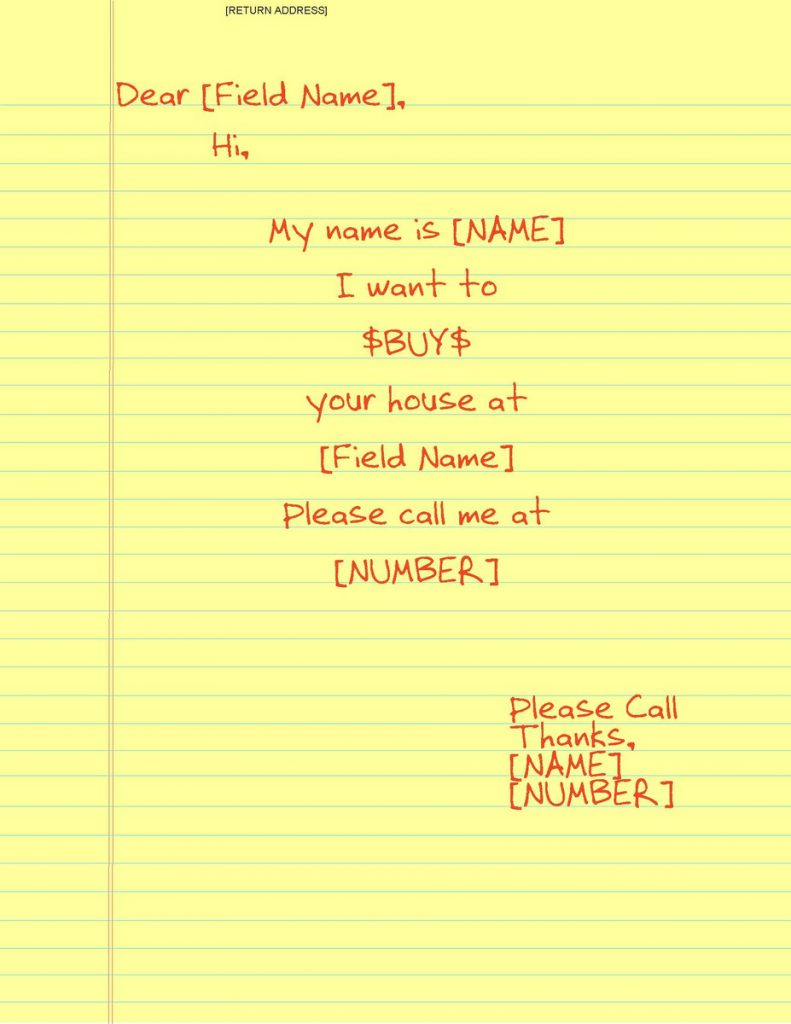
Direct mail is still the go-to for real estate investing marketing.
Check out these stats:
- 70% of U.S. consumers say snail mail is more personal than the internet (Data & Marketing Association)
- 42% of recipients read or scan direct mail pieces (DMA)
- 54% of consumers say direct mail is their preferred form of marketing (MarketingSherpa)
- 60% of direct mail recipients were influenced to visit a promoted website (USPS)
And THIS type of direct mail is particularly effective because yellow letters feel extra personal. They help you make a connection with the prospective seller.
They don’t HAVE to be hand-written — in fact, I would argue that hand-writing these letters is not the best use of your time.
Plus:
If you wrote as many letters as you needed to send out to get the leads necessary for growing your investment business, you wouldn’t have time to do anything else!
How many letters is that?
Epic Real Estate recommends sending at least 20 letters per day, 5 days per week, for 6 months!
The fact is:
Yellow letters are just like any other marketing tool — the more you send out, the more leads you’ll have coming in.
A commercial printer can print yellow letters for you using a font that looks hand-written and variable-data technology — which means that each piece can include unique property data, like the address and owner’s name!
2. Generate a 3,421% return on investment (ROI) with real estate investor postcards.
There is one downside to yellow letters…
Envelopes.
How do you make sure your prospects open them?
Whatever you to do your envelope — use colored ink, make a window, put a giant red stamp on it that says URGENT…
Your prospects have seen it before. They know they’re being marketed to! And at least some of them will throw your letter in the trash without even opening it.
How do you get around that?
With postcards!
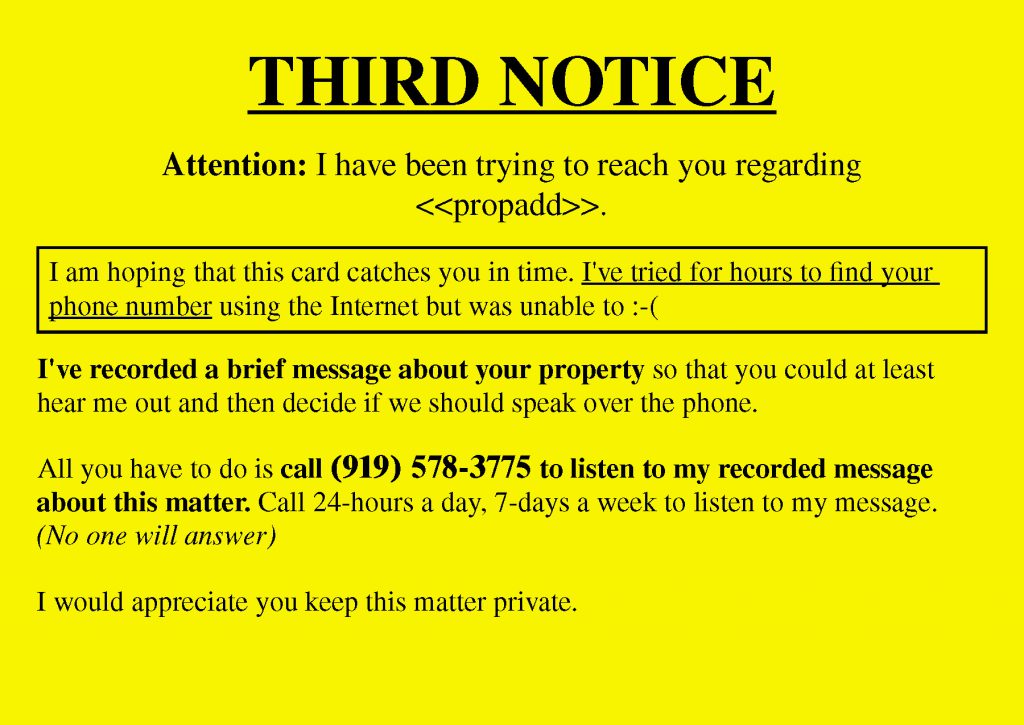
With a yellow-letter postcard (like the one shown above), you can immediately get your personal message to your prospects, creating more potential leads in a fraction of the time.
To wit:
- One investor generates a 3,421% ROI with his yellow letter postcards!
- Another investor makes $5k-$10k with every mailing of yellow letter postcards
Even if you opt for a traditional postcard template (example below), your message will be delivered more quickly and efficiently than with letters.

Here are a couple more PostcardMania client success stories from real estate investors who used traditional postcard marketing designs:
- This investing company brought in 414 leads with a We Buy Houses postcard template
- This company attracts 50 leads per week with their real estate investor postcards
3. Reach motivated sellers with a high-quality mailing list.
Whether you’re sending yellow letters or postcards, the key to any successful direct mail campaign is a good mailing list.
If you’re a new investor with no marketing budget, you can build your own mailing list for free using public records.
The most common investor real estate investor mailing lists include:
- Absentee owners
- Abandoned properties
- Probates
- Pre-foreclosures and foreclosures
- Apartment owners
- Expired listings
Of course, your list will be determined by what kind of properties you’re looking to buy. And HOW you acquire your list will depend on how much time you have on your hands.
You can spend hours collecting records via the courthouse, or purchase records from a reputable mailing list company and save yourself precious hours compiling your own list.
Once you have your list, mail to them repeatedly — I recommend monthly for at least 6 months — to build your credibility and increase your chances of reaching them at the right time.
4. Get on Page 1 of Google right now — guaranteed.
According to Search Engine Journal, 93% of online experiences begin with a search engine.
And studies show that 75% of internet users don’t scroll past the first page of results, so if your website doesn’t rank near the top, you’ll lose those leads to the competition.
If you want to GUARANTEE your spot on the first page, run a Google AdWords campaign (AdWords is Google’s paid ad platform).
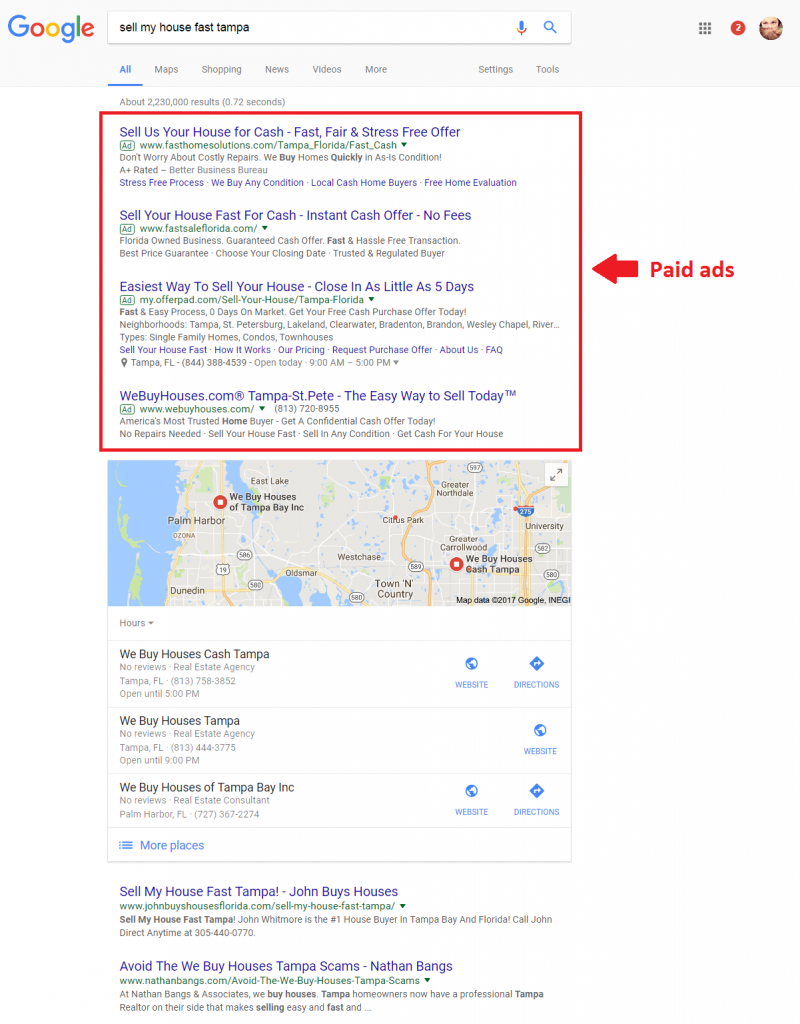
Google’s paid advertising is also known as pay per click, or PPC, because you’re only paying for clicks that your ads receive.
So why Google?
They control 77% of desktop search engine market share. That looks something like this:
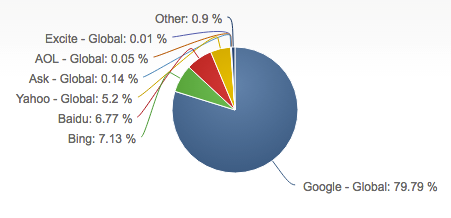
Yahoo!, Bing and the rest are good places to be, but Google is where you HAVE to be.
What’s nice about Google PPC ads is that you can test and tweak them as much as you want to see what gets the best results!
I recommend you start by setting a budget (say $50 a day) and playing around with it.
Some things to remember:
- Make your headline clear and concise — if it includes a benefit to your prospect, all the better
- Include an offer, like a free quote, to entice prospects to contact you
- Your ad should take interested prospects to a landing page that continues the communication and includes a lead-capture form
Here’s a good example…
This ad:

Leads to this landing page:

But even this good example could be improved.
I would suggest adding an offer to the PPC ad (maybe a free fair marketing evaluation), and having a landing page specifically all about redeeming the offer. This will increase the number of conversions on that page, which creates more leads for you AND result in a lower cost per click. (Google rewards advertisers that get people to convert on their landing page.)
Honestly:
Running a cost-effective PPC campaign can be pretty complicated.
There are so many variables that you need to constantly monitor your clicks to avoid wasting money. It’s probably worth the cost to hire a specialist to handle it for you. (PostcardMania offers PPC management, by the way!)
Download our free report: How to Do Pay Per Click Yourself (And Not Waste Your Money)
5. Reach 79% of internet users on Facebook.
There’s no ignoring social media when it comes to marketing strategies for real estate investors:
- 93% of marketers use social media (Fast Company)
- 90% of marketers say their time on social media is well invested (Social Media Examiner)
- 97% of adults between the ages of 16 and 64 say they have logged onto at least one social network in the past month (Global Web Index)
If you’re going to focus your social media advertising on one platform, make it Facebook, where 79% of American internet users have an account.
But…
Facebook’s organic reach (meaning the people you can reach for FREE) can be as low as 2%, so it’s worth paying up to promote your posts.
The platform’s ad manager is fairly intuitive, and gives you lots of options when it comes to the audience you want to reach.
You can target by:
- Location
- Age
- Gender
- Interests
- Contacts and more
You can also target people by which pages they “like” on Facebook. If someone likes a number of job search pages (like Monster or Glassdoor), they might be out of work and unable to pay their mortgage.
Or…
If they like a number of handyman/DIY pages, they may own an older home and be more likely to sell if a great offer pops up in the right place at the right time.
Once you’ve narrowed down your target audience, create an ad that will grab prospects’ attention and get them to engage with you.
According to Buzzsumo research, the three things that drive the most Facebook engagement are:
- Questions
- Images
- Video
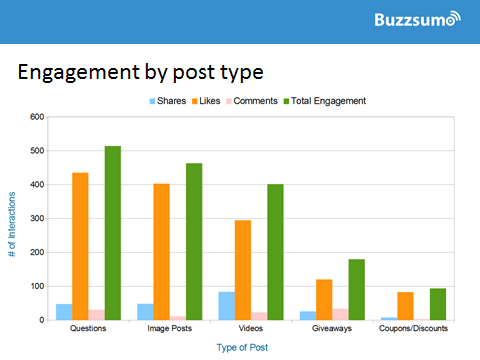
So be sure your ads and organic posts tick at least one of those most-engaged boxes.
6. Find off-market properties by networking.
How many times have you heard this:
It’s not what you know, but WHO you know?
Networking is one of the most important real estate investor marketing tools available — and it’s FREE!
The more people who get to know you and what you do, the better.
Here are some suggestions:
- Join a local real estate club
- Attend neighborhood association meetings
- Volunteer
- Develop relationships with other local businesses
- Develop your social media presence by posting a lot of images of your properties or flips — people LOVE to see real estate visuals, like this one:
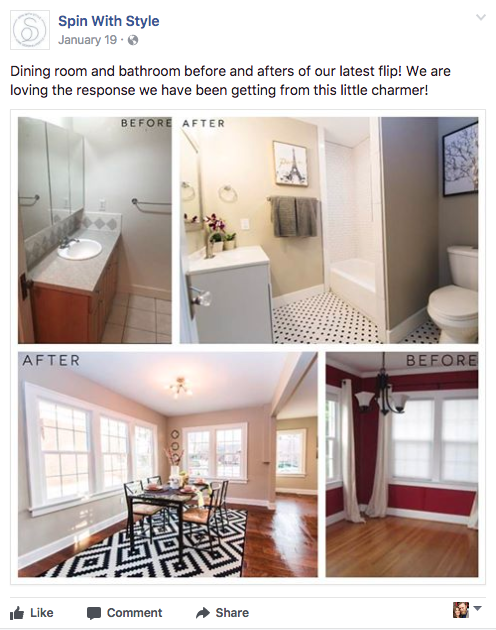
Have professional business cards printed and keep them with you at all times. You never know when you’ll meet someone — or someone who knows someone — with a property to unload.
7. Generate cheap leads with guerrilla marketing tactics.
When they’re first getting started — and have little to no marketing budget — a lot of real estate investors depend on guerilla marketing tactics for leads.
“Guerilla marketing” simply means using unconventional and inexpensive marketing techniques.
No doubt you have seen signs like this planted near a busy intersection:
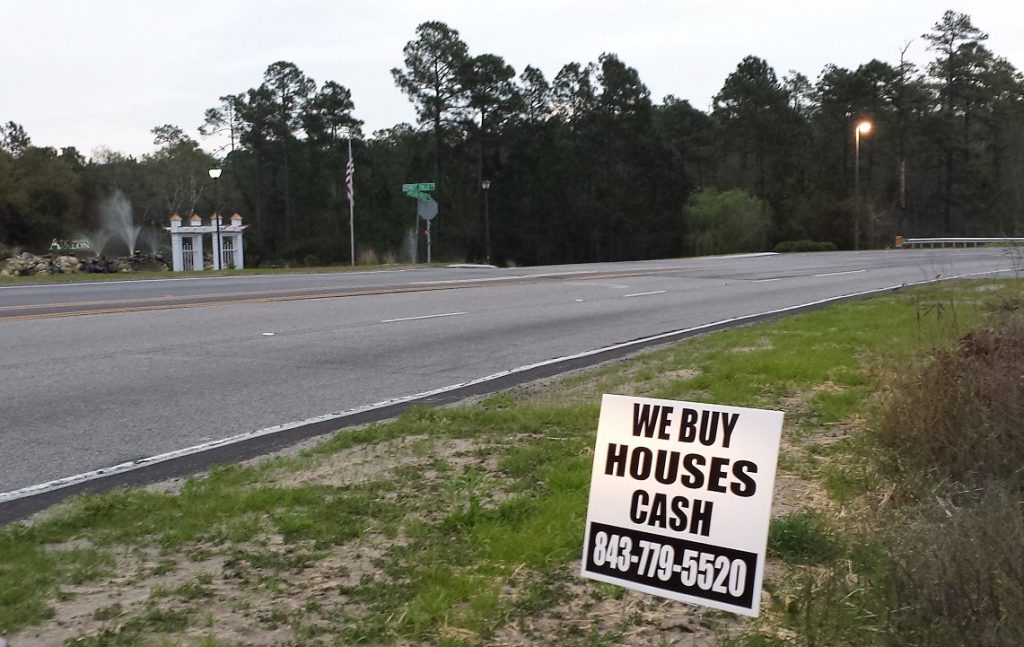
Bandit signs, like the one above, are far and away the most popular guerilla marketing tool, because they’re cheap and, perhaps more importantly, easy.
At less than $1 per sign, you can afford to buy lots of them and saturate entire neighborhoods — with enough money left over to pay a college student to put them up for you!
The problem is:
Bandit signs are unsightly and, in many places, illegal.
Other cheap real estate investor marketing tactics include:
- Fliers (leave them in laundromats and other public spaces)
- Human billboards (literally walking around wearing a sign that says “I Buy Houses!”)
- T-shirts (slightly less conspicuous than a sandwich board)
The only limit, really, is your imagination…
Well, and the law!
8. Avoid losing 75% of leads with a professional website.
Not all potential sellers will be ready to call you right away.
When an interested prospect sees your marketing, the first thing they will do is check you out online.
Which is why it’s VITAL that you have a professional, attractive website. (Stanford Web Credibility Research shows that 75% of people will judge your business based on the appearance of your website!)
Even if you’re technology-averse, you can have a business website designed for you for not a lot of money.
It doesn’t need to have a bunch of bells and whistles!
But it should ABSOLUTELY have:
- Your contact information clearly visible on every page
- An about-us page that tells prospects who you are (extra points for a real photo of you!)
- Responsive design (so visitors can view it easily on their desktop or mobile device because it RESPONDS to the type of device they’re on)
- A lead-capture form
I mentioned lead-capture forms in #4. Let me explain a bit about them. The white box below is a lead-capture form:
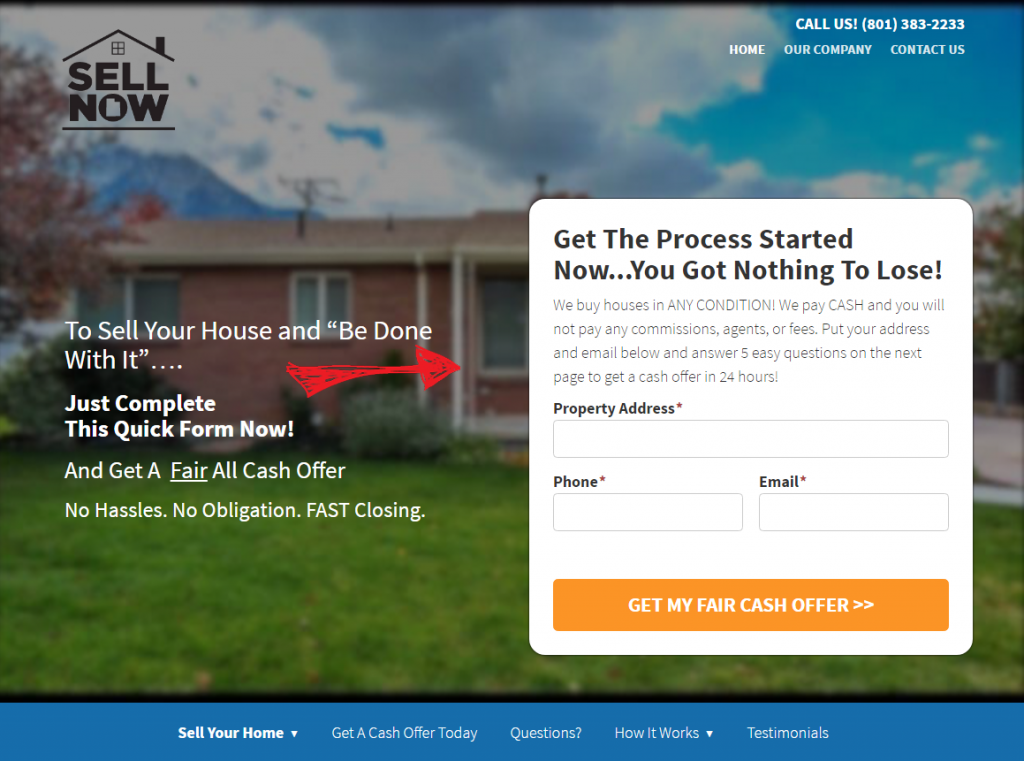
Personally, I think this form is asking for too much information! Asking for all of that data decreases the likelihood that people actually will fill it out. All you really need at this point is your prospect’s email address.
Here’s why lead-capture is so important:
A Kissmetrics study showed that 96% of website visitors are not yet ready to do business with you.
So what happens to those leads?
They leave your site, and they’re gone.
And when they ARE ready to sell, maybe they’ll remember you…
But they probably won’t.
A lead-capture form gives interested prospects a reason to interact with you (by offering them something of value in exchange for their contact information, like a free quote in the example above).
Then you can follow up with them via email until they are ready to sell! (More on this in a second!)
You don’t have to offer a free quote. In fact…
Prospective sellers have lots of questions. You could make your lead-capture form a place for them to ask!
You can download our ultimate guide to small business website design for FREE here.
9. … Or capture leads with a mass-texting software.
Of course, some prospects WILL want to call you…
While you’re eating dinner or at 7 a.m. on a Sunday, almost inevitably!
With call software (such as LiveComm), you can automatically handle these callers AND collect their phone numbers so you can follow up with them.
It works like this:
- You include a dedicated phone number on your postcards, bandit signs, etc.
- People who call that number hear a prerecorded message from you
- The software captures the phone number of everyone who calls
- Every cell number that is captured is added to your texting database
Whether you’re buying or selling, it’s a good idea to automate as much of this process as possible.
The more marketing you do, the more calls you will receive — and you can only handle so many!
With a prerecorded message, prospects can find out if they’re interested in your offer without you even having to speak with them.
This helps sort out many of the unqualified leads right away!
Then…

When you want to follow up, you can communicate with hundreds of leads (whether they’re sellers or buyers) at the same time — with just one text.
10. Close 80% more deals with consistent follow up.
A statistic often cited by sales professionals it that 80% of sales occur on the fifth contact or later.
That’s why follow-up is a crucial aspect of ANY successful marketing plan.
This is especially true for real estate investors…
Because you never know where a prospective seller is in the process.
They might be just starting to think about unloading their home, or they might even be in denial.
Then again, they could be ready to sell right away — you just don’t know!
Once you have a prospective seller’s email address (after you’ve given them their free quote or answered their question, of course!) reach out to them regularly to see if they’re any closer to being ready.
Don’t have time to dial numbers every day?
You can automate the process by setting up an email drip campaign (a series of emails that go out at specific intervals) using Constant Contact, MailChimp or any other number of providers (PostcardMania also offers email marketing!).
Each email should just be a gentle touch that reminds them of your interest in their home and encourages them to call you.
11. Increase response up to 400% with Google follow-up ads.
But what about prospects who visit your website and don’t fill out the lead-capture form?
Not if you use Google follow-up ads (sometimes called remarketing or retargeting)!
Here’s how it works:
- A prospect receives your postcard and wants to know more about you
- They go to your website, but they’re not quite ready to sell, so they leave and go on with their day, but…
- While they were on your site, they were “cookied” with a piece of code that tells Google to start showing them your online ads
- They see your ad (which looks just like your postcard) as they browse the internet — on literally millions of sites across the Google network
- When they’re ready to sell, YOU are top of mind!
Studies show these Google follow-up ads can improve response up to 400% (CMO.com)!
And…
You can add them to your direct mail campaign (we call it DirectMail2.0), so all of this happens automatically.
That means:
Once you set it up, you never have to think about it again.
Plus:
DirectMail2.0 campaigns also include:
- Mail tracking, which shows you when your postcards will arrive in mailboxes
- A call tracking number, which rings directly to your phone, but is counted and recorded so you can see how many calls your campaign is bringing in (and listen to them!)
- An online dashboard where you can easily access all of your campaign data — including how many times your banner ads have been shown and how many people click on it — in real time
Pretty sweet, right?
One of our investor clients (the same guy I mentioned above, who achieved a 3,421% ROI) used call tracking numbers on his postcards to nail down his most successful campaign. One of his cards generated 665 calls — 502 of them unique!
12. Be found by 75% of people who are actively looking for help online — for FREE.
A PPC campaign can get your website on the first page of Google (where, remember, 75% of people start and end their online search) — for a price.
But by focusing on Search Engine Optimization (SEO), you can get it there for free! It just takes time and effort.
What is SEO?
SEO helps Google find your website when someone in your area is looking for help selling their home.
The better your SEO, the higher your website will show up in the search results and the more traffic you’ll receive.
Here are the current (as of May 2017) search results for the query “how do I sell my house fast”:
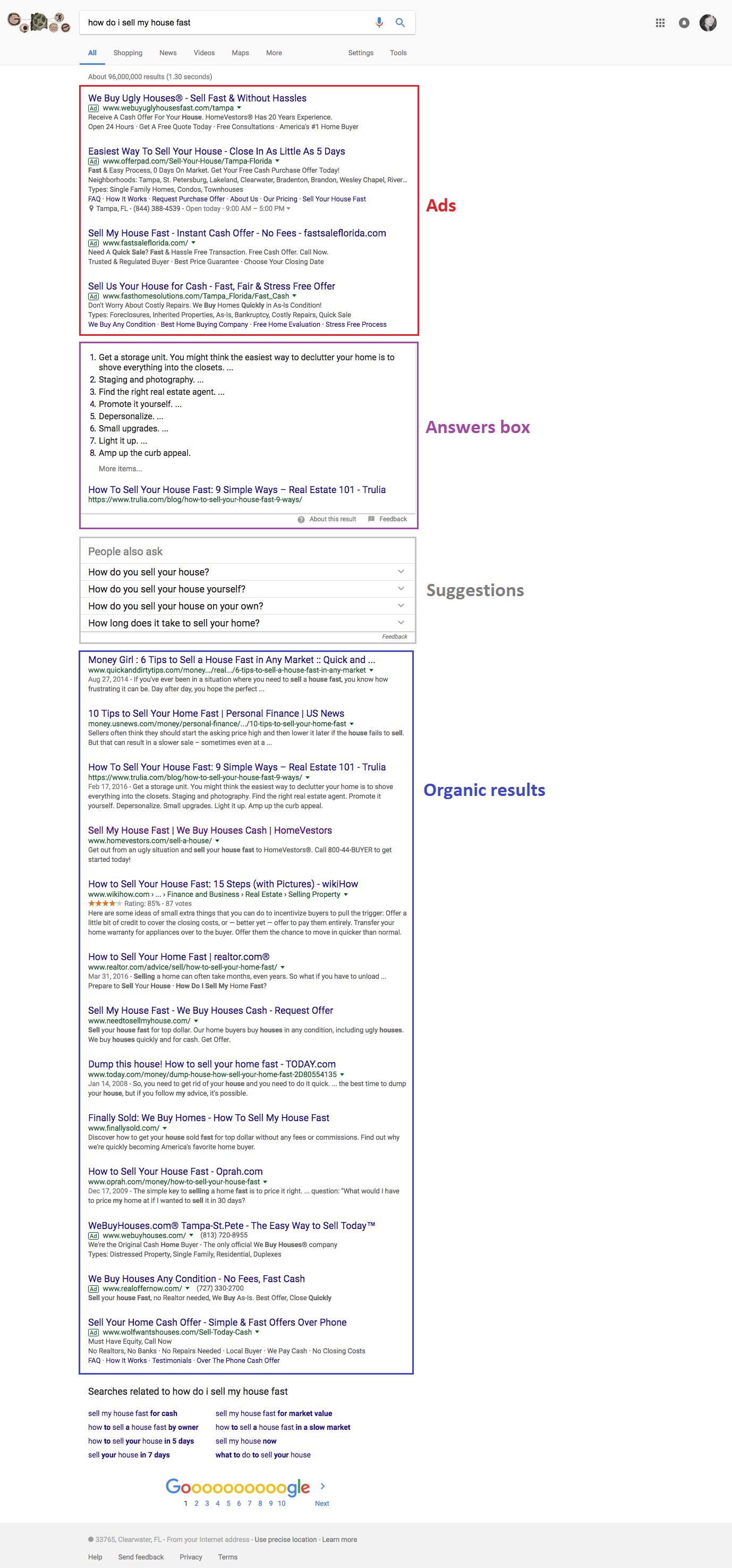
To say that this term is competitive is an understatement. There are 17 results on page 1, not including the Google Answer Box or the suggested searches.
- 7 of those results are ads (41%)
- 7 of those results are from helpful articles, i.e. Today.com, Wikihow.com, etc. (41%)
- And only 3 of those results are from real estate investor websites (18%)
That means your site had better be on its SEO game if you want to show up and be relevant in this arena!
To optimize your site, include the keywords your prospects will be searching for on your page copy — ESPECIALLY in your page titles, headlines and sub-headlines.
Keywords like:
- Sell my house fast
- Sell your house fast
- Quick house sale
- Sell my home
- We buy houses
- Buy my house
You get the idea.
Here’s a great example one of the websites that DOES show up in the above search results organically. This page has been optimized for the keywords sell my house:

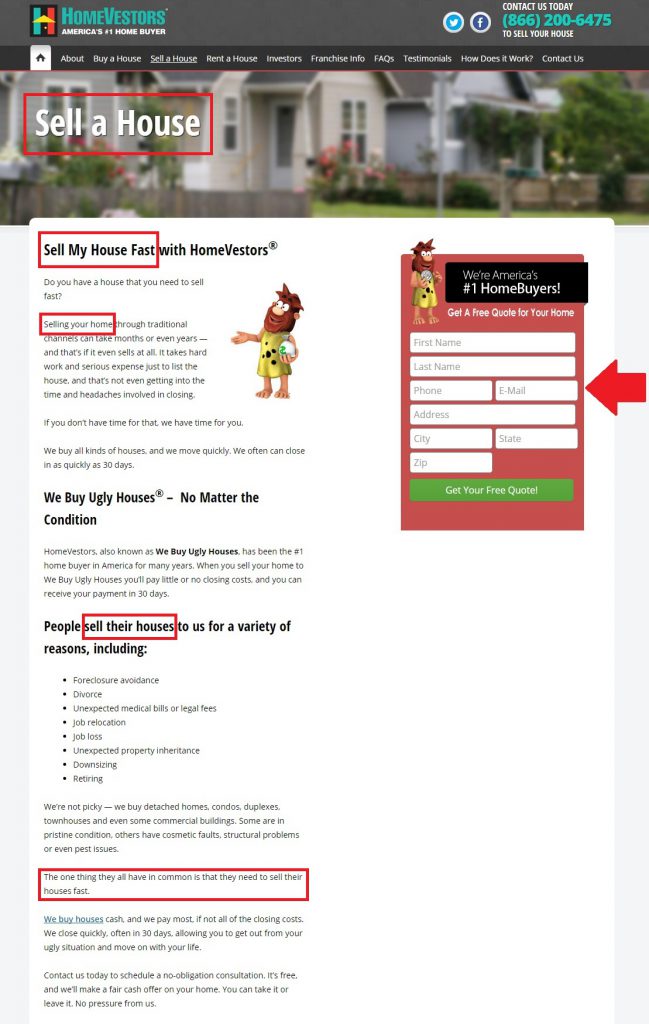
Their page title, URL, call to action (in the upper right hand corner) and headline all use the same keyword phrase, and the rest of the content is actually useful for people doing research on how to “sell my house.”
Having a form on the page is also a must-have move for both SEO and lead capture. The more traffic that comes to this page from a “sell my house” search and fills out that form, the better HomeVestors will rank for “sell my house.”
And, as I mentioned, lead capture is also a must if you want to stay in contact with these people and follow-up with them.
Which you should!
13. Track and tweak your campaigns to avoid wasting marketing dollars.
Whether you’re a new investor with no budget or have been in the game for decades, no one likes wasting money!
But if you don’t track your marketing results, that’s exactly what you’ll end up doing.
You should ask EVERY SINGLE PERSON who reaches for your services how they heard about you. And be sure to keep track of this information and tie it to each lead’s contact information in your database somehow!
If you’re a more established investor, you might do this through your CRM (customer relationship management software), but if you’re new the game, it might just be a column on a spreadsheet.
Either way…
Your marketing budget can’t afford for you NOT to track this!
Once you get a good feel for where most of your leads are coming from, you can strengthen those efforts to generate even MORE of them…
And tweak or eliminate the campaigns that aren’t performing as well!
So there you have them: 13 marketing ideas for finding more real estate deals.
Try them, test them, tweak them — but whatever you do, don’t GIVE UP!
Remember that your prospects are working on their own timeline. It could take up to 12 months for a campaign to produce real, measurable results.
Are you ready to start a campaign for your real estate investment business? Check out our gallery of real estate investor postcard templates that have already worked for our clients!
If you have questions about anything mentioned here or need help getting started, call one of our marketing consultants at 800-628-1804 — it’s FREE!
Best,
Joy
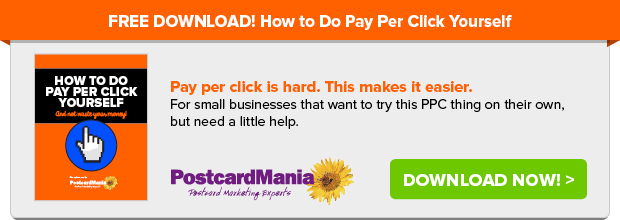
4 Comments
I’m so glad you enjoyed! Thanks for reading.
This is totally overwhelming. I need a marketing presence but, it’s just so overwhelming.
Hi Dave.
I completely understand! Have you ever talked to one of our marketing consultants? Their advice is ALWAYS 100% free and they can help you come up with a simple marketing plan that gets you the results you need to grow your business. Give us a call at 800-628-1804 – we would be so happy to help!

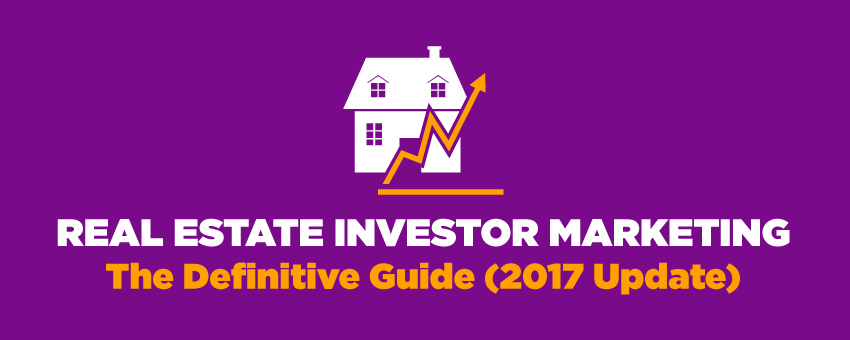





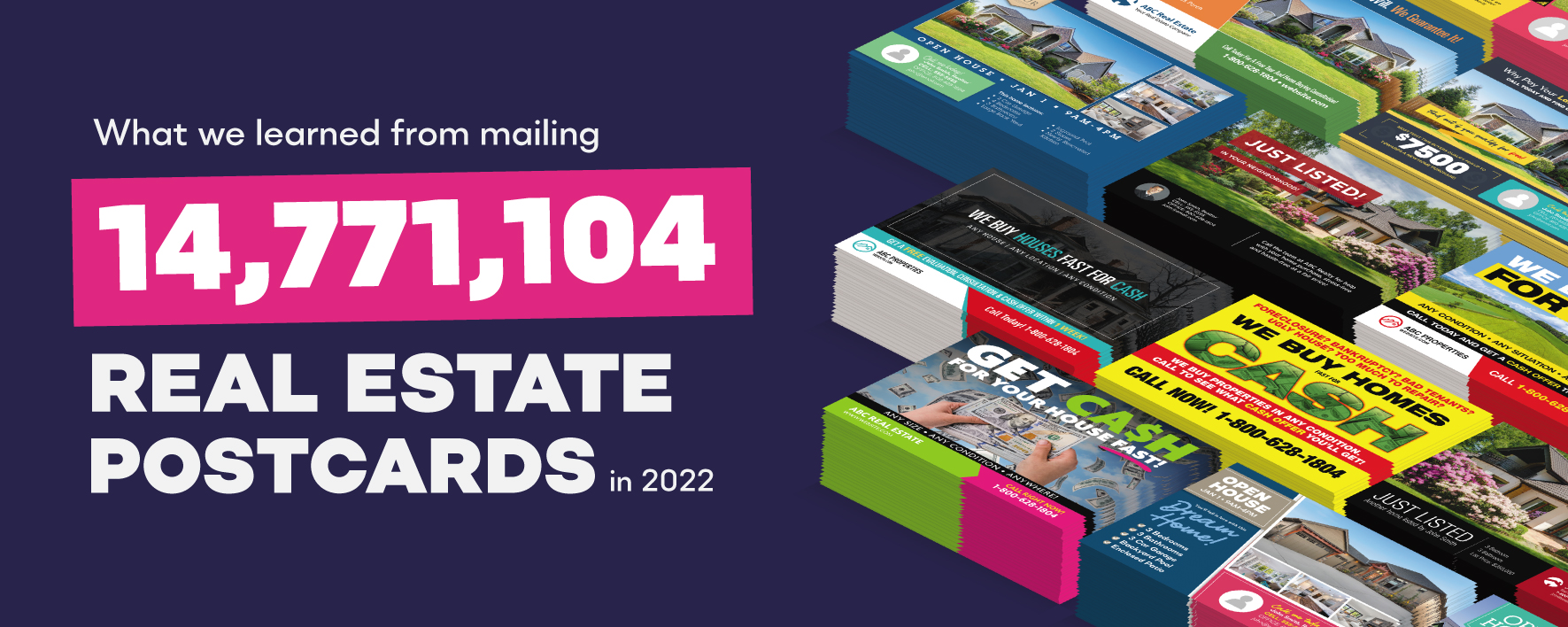





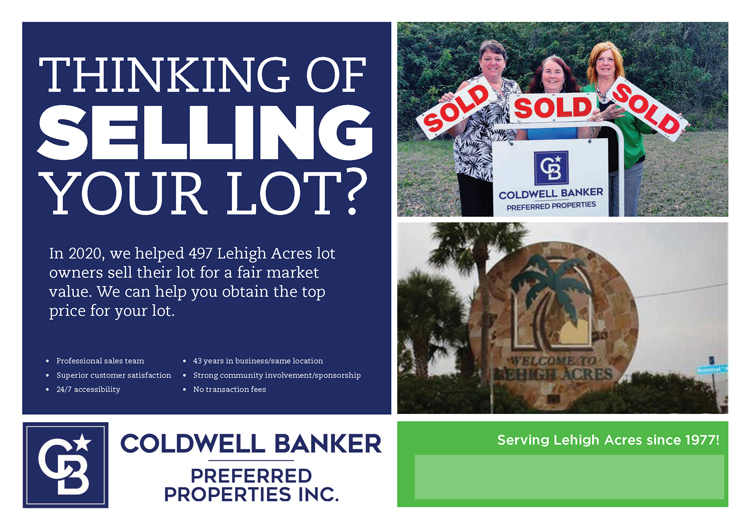




Good Job, excellent article, i loved it the way that you explained about real estate